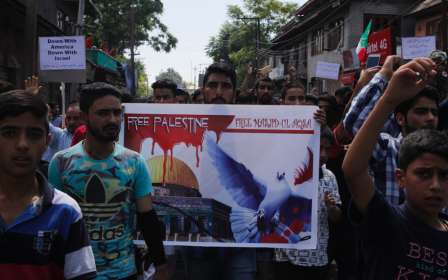India's annexation of Kashmir is straight out of the Israeli playbook

Over the past few years, Kashmiri scholars have been making the argument that India-administered Kashmir ought to be recognised as an occupied territory.
With more than 700,000 Indian soldiers, paramilitary and police in the region, the most militarised region on earth, they argued that Kashmiris were living under client leaders held firm by the might of the Indian military establishment.
To many Indians, the project to abrogate Kashmir's 'special status' within the Indian constitution has finally reached fruition
Since the insurgency began in the late 1980s, more than 70,000 people had been killed, a further 7,000 enforced disappearances, thousands blinded and maimed by pellets and live ammunition; the argument was not hard to make, but the veneer of India's democracy, in a rough neighbourhood, made it to some, a hard sell.
But on Monday morning, the veneer dissipated.
Speaking in parliament, India's home minister Amit Shah held out a stamped and signed letter from India's president announcing that the country would be abrogating a special clause in the constitution concerning Kashmir. Article 370, the clause in India's constitution that illuminated Kashmir's semi-autonomous status within the Indian Union, including the ability to handle its own affairs (besides defence, finance, communication and foreign affairs), the right to its own constitution, ability to make laws, as well as its own flag, would be immediately scrapped.
The Indian government said it would change the constitution in spite of multiple court rulings, including the High Court in Jammu and Kashmir and the Supreme Court in Delhi that ruled that the clause could not be tampered with.
But to many Indians, the project to abrogate Kashmir's "special status" within the Indian constitution, started by the Rashtriya Swayamsevak Sangh (RSS), the right-wing Hindu nationalist group, and later floated as an election issue for the ruling Bharatiya Janata Party (BJP), has finally reached fruition.
In so doing, India turned from administrator to fully fledged coloniser, following in many ways, Israel’s methods to accomplish total control of the state and its people.
Following the Israeli playbook
For decades, the RSS party has been calling for the dismantling of Article 370 in its bid to rebuild a Hindu India. In the 1980s, the BJP began campaigning with the promise of majoritarian rule.
Revoking article 370 paves the way for a full settler-colonial project in Kashmir, much like Jewish settlements in the West Bank
This included ending the "privileges" enjoyed by Muslims - even if they were and remain the poorest and most undeveloped community in India. It also included framing Kashmir as one dotted by shrines and temples, and part of Hinduism's glorious past in the Himalayas.
Part and parcel of this attempt has been the ramping up of the Amarnath Yatra pilgrimage in southern Kashmir. As Mona Bhan, a professor at Syracuse University, writes in Resisting Occupation in Kashmir, the past decade has seen the Indian government restore temples to further "tie Kashmir to India through spiritual and religious connections".
Cancelling Article 370 is part of a fulfilment of that promise of reinvigorating Hindu India, in a way that may be both supremacist and democratic, even if fundamentally flawed.
"The type of 'democratic' state exemplified by Israel – and not Pakistan – is the model the Hindu nationalist movement, led by its core RSS organisation, aspires to establish in an Indian variant," Sumantra Bose, professor at the London School of Economics and Political Science, writes.
More importantly, it also paves the way for a full settler-colonial project in Kashmir with the next stage likely to involve Hindu-only enclaves, much like Jewish settlements in the West Bank.
The Pandit question
Though tens of thousands of Kashmiri Hindus, known as Pandits, left Kashmir in the 1990s in fear of their lives as the insurgency there deepened, Kashmiri Muslim leaders have repeatedly called for their return.
Modi is a master manipulator and puppeteer of majoritarian ambition, scapegoating widespread economic failure to those who fall outside the national project
Kashmir does not have a history of communal tension between Muslims and Hindus. The attempt to bring Pandits and other Indians back as settlers rather than equal residents is seen as a provocation.
Like the Israeli government has done repeatedly, the Indian government has tried its utmost to frame the problem in Kashmir as a religious issue (between Muslims and Hindus), underplaying the roots of the political dispute and overstating the role of Islamic extremism as a ruse to make a military crackdown not just necessary but unavoidable. Pakistan has supported the armed movement, but its security agencies also fear Kashmiri independence as much as India does.
As the BJP sees it, changing the demographics in Kashmir, or flooding the region with Indian Hindus, would circumvent the political aspirations of Muslim-Kashmiris and solve the seemingly intractable Kashmir problem forever. It would also secure Modi's legacy. The economy might fail, the cities might drown, farmers might starve, but he will be remembered for securing Kashmir. The thirst for a strong-man leader in India remains palpable.
It has been described as the darkest day in India's democracy. But for now it is Kashmiris who bear the brunt
Modi's time in office, either as the chief minister of Gujarat in the early 2000s, or as PM of the country since 2014, show that his popularity increases each time Hindu-Muslim tensions rise in the country. He is a master manipulator and puppeteer of majoritarian ambition, scapegoating widespread economic failure to those who fall outside the national project, be it Muslims, or Kashmiris, or those who dare to express dissent.
Kashmiris are used to strife in the valley. But in the days leading up to the announcement, the government inflicted a series of psychological trauma on the local population.
First, the Indian government instructed Hindu pilgrims in southern Kashmir and tourists to leave, on the basis of a security threat. It set off unprecedented levels of panic in the region, which was parroted by mainstream Indian media. This turned out to be merely a ruse to clear out non-Kashmiris from the region ahead of the announcement.
Families cancelled engagements and weddings, and stocked up on food and fuel. Others, looking after the elderly, searched for emergency medical supplies. Businesses prepared for the worst, cancelling orders, and their hotels emptied out.
Without any further communication, the Indian government then deployed 35,000 additional troops to the valley, cut all communications, including internet, telephone (including landlines) and select cable television.
Kashmiri leaders, those who worked at the behest of the Indian state, and to whom most Kashmiris have shown little allegiance or interest, were placed under house arrest, too.
Finally, a curfew was imposed. The streets were cleared and soldiers took over police posts and were sent to street corners.
With the communication blackout, there is no indication of what is actually taking place in the valley. If Kashmiri media have been shut down, there are significant restrictions on Indian journalists currently on the ground. As of now, it is not even clear how many Kashmiris know that the Indian government has changed their social contract with the state.
It has been described as the darkest day in India's democracy. But for now it is Kashmiris who bear the brunt.
The views expressed in this article belong to the author and do not necessarily reflect the editorial policy of Middle East Eye.
This article is available in French on Middle East Eye French edition.
Middle East Eye propose une couverture et une analyse indépendantes et incomparables du Moyen-Orient, de l’Afrique du Nord et d’autres régions du monde. Pour en savoir plus sur la reprise de ce contenu et les frais qui s’appliquent, veuillez remplir ce formulaire [en anglais]. Pour en savoir plus sur MEE, cliquez ici [en anglais].




